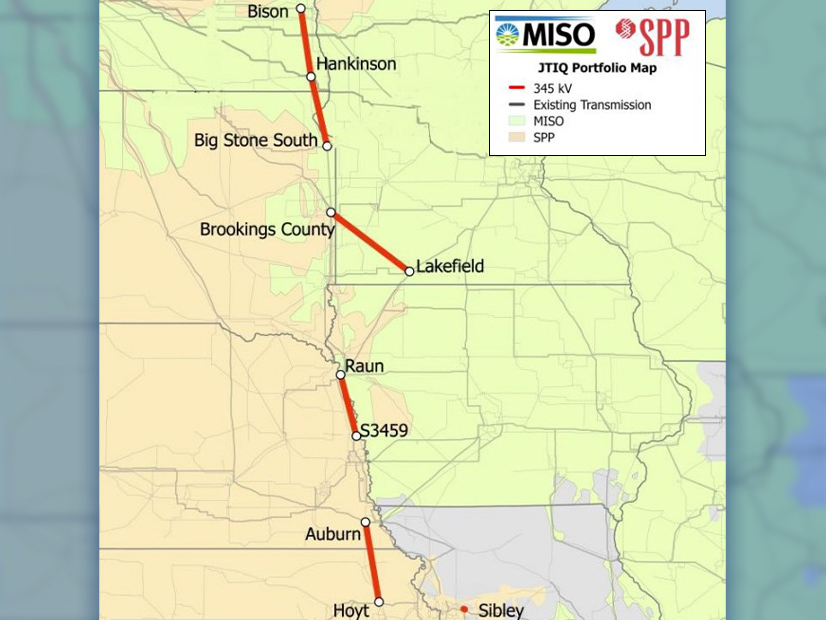CARMEL, Ind. — Weeks after the nearly $2 billion Joint Targeted Interconnection Queue (JTIQ) transmission portfolio was awarded a $465 million Department of Energy grant, MISO and SPP are switching their proposed cost allocation for the projects.
Now, all costs of the JTIQ portfolio should be assigned to interconnection customers, MISO and SPP have agreed. The new cost allocation will replace the RTOs’ previously proposed 90% assignment to interconnecting generators with the remaining 10% to load.
The RTOs have further said all operations and maintenance costs on the projects will be borne by the constructing RTO’s load.
Last month, DOE announced the JTIQ portfolio will receive $464.5 million from the department’s Grid Resilience and Innovation Partnership program. (See DOE Announces $3.46B for Grid Resilience, Improvement Projects.)
MISO Director of Resource Utilization Andy Witmeier said MISO, SPP and states are in the middle of negotiations with DOE before they can receive the money.
Speaking at a Nov. 15 Planning Advisory Committee meeting, Witmeier said the grant will help get the JTIQ portfolio online “to the benefit of generators waiting to interconnect.” And he said a more simplified cost allocation likely will help move the projects across the finish line, even though MISO and SPP had settled on the 90/10 allocation almost a year ago.
“This is what MISO and SPP believe will have the most success in getting approved,” he said.
Witmeier characterized the change in direction on cost allocation as a “small pivot.” He said MISO always would have used the grant money to apply for the load’s share of project costs first, and the $464 million grant more than takes care of the tab load would have picked up under the original cost allocation proposal.
Witmeier said MISO and SPP concluded DOE’s funding can address rate complexities the 10% allocation to load will introduce in how costs will be spread across load and how operations and maintenance costs will be handled. He said using a 100% allocation ensures entitlements are assigned to the constructing region and reduces risk that load in one RTO is supplementing transmission in the other in the unlikely case not enough generation shows up to fund the lines.
Witmeier said the 100% method is a “much simpler rate design, if you don’t have load in that calculation.”
He also said the 100% allocation to generators matches SPP’s existing interconnection upgrades allocation and allows MISO and SPP to approach FERC with a “consistent approach.”
“The 100% is a small shift for MISO, but the 90/10 was a big shift for SPP,” he said.
In MISO’s individual queue process, interconnection customers bear 100% of interconnection costs except when network upgrades are 345 kV or higher, when the 90% to interconnection customers, 10% to load allocation kicks in.
In an email to RTO Insider, SPP confirmed the new rate design will be a better fit with its current cost allocation for generator interconnection projects.
Xcel Energy’s Carolyn Wetterlin said her utility agrees with the change. She said a 100% allocation will result in a “cleaner filing” to FERC and less costs borne by ratepayers in MISO and SPP.
However, the Coalition of Midwest Power Producers’ Travis Stewart said the change is significant and interconnection customers have concerns.
National Grid Renewables’ Maggie Kristian said some generation developers weren’t comfortable with load’s small share in the allocation to begin with. She said it’s disappointing to see even that small amount reduced to nothing.
Witmeier said the 100% cost allocation to projects will apply only to the first JTIQ portfolio. He said MISO and SPP will have to “go back to the drawing board” for future JTIQ portfolios and devise a new cost allocation. The RTOs hope FERC gives its blessing for JTIQ planning to become a cyclical process and replace their affected system study process.
Witmeier also said there are always lingering concerns about free riders in transmission cost allocation. He said while interconnection customers might be upset to completely cover the JTIQ bill, load is probably unhappy taking on 100% of MISO’s long-range transmission plan costs.
“We’ve been having this discussion in the MISO community for the past 15-20 years, what is the appropriate formula for generation and load,” Witmeier said.
He said while MISO will hear written concerns on the allocation change through Dec. 6, it’s unlikely to influence changes to MISO and SPP’s direction.
The RTOs also found a change in adjusted production cost benefits of the JTIQ portfolio between MISO and SPP since it first conducted a benefits analysis in 2021. Now MISO can expect to see a $76.5 million benefit, while SPP will experience $99.3 million in benefits over 20 years. The RTOs originally found a $55.7 benefit for MISO and a $132.9 benefit for SPP over the first 10 years the projects are in service.
As far as how the DOE grant will be split between MISO and SPP, that’s unknown, Witmeier said. He said that depends on how many projects apiece from the MISO or SPP clear their respective interconnection queues.


